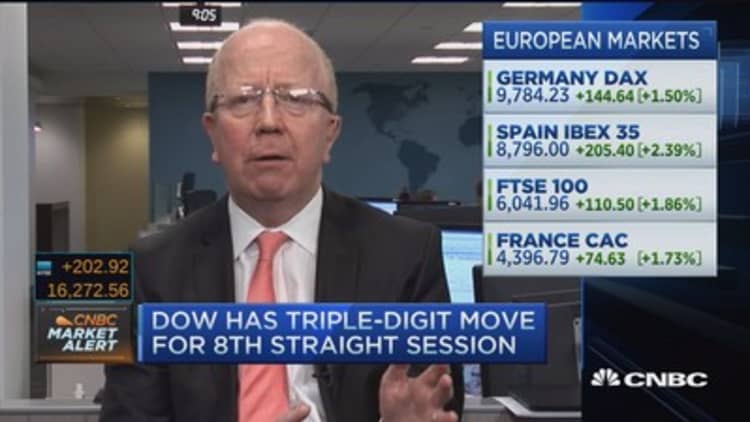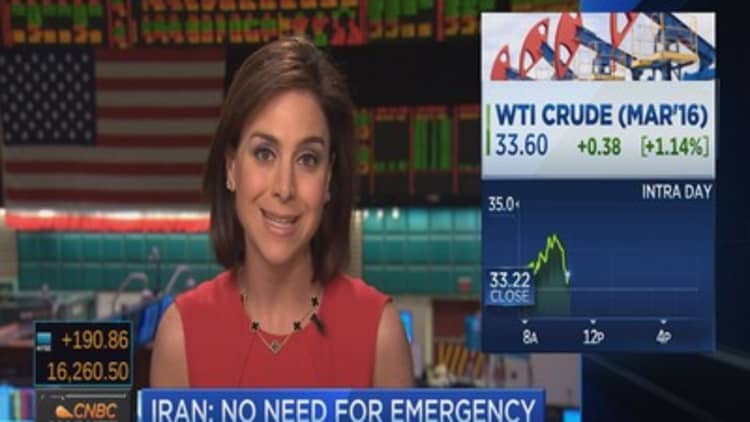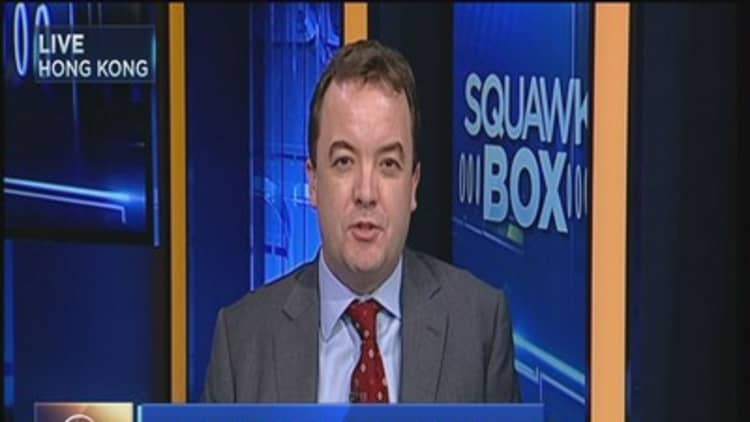



U.S. stocks closed more than 2 percent higher Friday, the last trading day of January, after the Bank of Japan unexpectedly adopted a negative interest rate policy for the first time. Encouraging earnings reports, a better-than-expected Chicago PMI report and some stabilization in oil prices also helped push equities higher.
(Tweet This)
The major averages still posted their worst January in at least seven years. On a monthly basis, the Nasdaq composite fell 7.86 percent for its worst month since May 2010. However, Friday's sharp gains pushed the three indexes into positive territory for the week.
"I think the BOJ got it going," said Jeremy Klein, chief market strategist at FBN Securities. While he was skeptical of the actual benefit of the negative rate policy to the economy, he said "it signals they are basically walking their talk."
Stocks rallied into the close, with the Dow Jones industrial average ending up more than 390 points. The S&P 500 surged nearly 2.5 percent to close within 10 percent of its 52-week intraday high, out of correction territory. Information technology gained more than 3.5 percent to lead all 10 sectors higher.
"I think investors were concerned about missing a rally driven by reduced uncertainty about oil, China and central banks," said Doug Cote, chief market strategist at Voya Investment Management.
The major U.S. averages extended gains after the Chicago PMI showed 55.6 in January, topping expectations of a 45.0 print and above December's 42.9 read.
"This big uptick in the PMI — there's relief that we won't be dipping below 40 on the ISM (manufacturing) Monday," Klein said.
Traders also attributed some of the gains in stocks to short covering and month-end buying.
"I think it's an important inflection point here," said Art Hogan, chief market strategist at Wunderlich Securities. If "we break the correlation with energy and start focusing on earnings, it's a much healthier environment for investors."
U.S. crude oil futures settled up 40 cents, or 1.20 percent, at $33.62 a barrel, for its first four-day win streak since April.
Oil held higher after Baker Hughes said the U.S. oil rig count fell by 12, marking a sixth-straight week of declines. Earlier, oil briefly pared gains to turn lower. An Iranian official said the country would not join an immediate OPEC production cut, Dow Jones reported.
Read MoreOil rallied this week on false hopes for a deal
The Market Vectors Semiconductor ETF (SMH) closed up 4.1 percent, as Skyworks climbed more than 6 percent on earnings that topped expectations, according to StreetAccount.
Visa jumped 7.4 percent and Goldman Sachs gained nearly 2.9 percent as the top two contributors to gains in the Dow as all constituents closed higher.
The Nasdaq composite also ended more than 2 percent higher, but underperformed as Amazon closed down 7.6 percent. Apple closed up more than 3 percent. The iShares Nasdaq Biotechnology ETF (IBB) turned higher to close up about 1.4 percent, but still fell more than 20 percent for the month, its worst going back to its inception in 2001.
The Dow transports closed up more than 3 percent with Matson and JetBlue leading all constituents higher.
Read MoreThese Dow stocks should rally if yen plunges
Global equities climbed after the Bank of Japan's surprise announcement, with the Nikkei reversing mild losses to close up 2.8 percent. The Shanghai composite closed 3.09 percent higher. European stocks ended more than 1 percent higher, with the STOXX 600 up more than 2 percent.
"That (BOJ move) actually comes as a shock. I expected them to be dovish, but negative interest rates was a shock," said John Caruso, senior market strategist at RJO Futures.
"Anytime central banks push interest rates lower, stocks applaud it," he said.
Treasury yields edged lower to hit multi-month lows, with the at 0.78 percent and the 10-year yield near 1.93 percent.
"I think much of the rally (in bonds) can get reversed with the stock market doing better... and stabilization in oil," said Bryce Doty, senior fixed income manager with Sit Investment Associates.
Read MoreFed funds futures pricing no rate hikes in 2016: CME data
The U.S. dollar climbed more than 1 percent against major world currencies, with the euro near $1.083 and the yen at 121.06 yen against the greenback.
Overnight, the Bank of Japan announced a negative interest rate policy. The move comes after the Federal Reserve kept rates unchanged at its meeting this week and noted the central bank is "closely monitoring" global economic and financial developments and assessing their implications for their outlook.
Speaking last week, European Central Bank President Mario Draghi raised hopes of stimulus as soon as the March meeting.
Read MoreBOJ's negative rates are 'economic kamikaze': Analyst
"At the end of the day, I don't think it's a long-term fix to what we have going on," said Tom Siomades, head of Hartford Funds Investment Consulting Group.
"I'm disappointed that we started the year like we did, how we reacted so strongly to China like we did," he said. "I'm still optimistic, but a lot of it hinges on Fed policy and a better job of negotiating and (communicating) what their policy is."
Dallas Fed President Robert Kaplan, an alternate member of the FOMC, said in an interview with Reuters Friday that the central bank needs more time to weigh the global risks to the U.S. economy. He also said the Bank of Japan stimulus will clearly affect the dollar and that policymakers are "mindful of that."
San Francisco Federal Reserve Bank President John Williams said on Friday the central bank is on a path to gradually raise interest rates. He is optimistic that the U.S. can weather the storms from abroad and that the U.S. economy is "doing well," Reuters reported.
Read More Countries weakening currencies for global growth: El-Erian
"Bank of Japan certainly a new constructive (development for stocks) and the backdrop of the overall earnings structure is better than bad," Hogan said.
Visa closed up 7.4 percent after reporting , although revenue missed slightly. The credit card issuer also affirmed its full year earnings forecast, surprising some analysts who had expected a cut.
Microsoft gained 5.8 percent after , helped by improvement in its cloud services business as well as cost-cutting.
Amazon.com reported quarterly on revenue also slightly below forecasts. The stock closed down 7.6 percent, off session lows, despite the highest-ever quarterly profit ever posted by the online retail giant.
Facebook extended Thursday's stellar gains to close up 2.8 percent, at a record.
Consol surged 17.6 percent, ending mildly higher for the year so far. The coal and natural gas producer reported on Friday an adjusted loss for the fourth quarter but said that its free cash flow would help the firm "ride out this volatile market."
Dow futures rose more than 100 points in pre-market trade as Microsoft climbed but Chevron declined after the firm unexpectedly posted a loss for the first time since 2002, hit by the slump in oil prices. The stock held 0.6 percent higher in the close.
Stocks closed higher for the week Friday, but were still down 5 percent or more for the year so far.
This week's gains created a "consolidation phase" that "reflects improved short-term momentum in a muted reaction to widespread short-term oversold 'buy' signals," BTIG Chief Technical Strategist Katie Stockton said in a note.
"Our market internal measures still collectively support a relief rally, so we expect upside follow-through next week on the back of strength today. Our bearish bias suggests that additional strength be used to take down exposure," she said.
Major U.S. Indexes
Stocks fell sharply in volatile trade at the beginning of the year as a plunge in oil prices and uncertainty about China elevated concerns about global growth.
"To get out of a growth scare we need evidence that we don't need to be scared about growth," said Brian Nick, head of tactical asset allocation at UBS Wealth Management Americas.
"I think the focus is on the GDP number. The expectations were not high. … I think the risks were if we got a much worse number. That hasn't materialized," he said.
The advance read on the fourth-quarter showed U.S. GDP increased at a 0.7 percent annual rate, in-line with expectations but down sharply from the 2.0 percent rate in the third quarter. The economy grew 2.4 percent in 2015 after a similar expansion in 2014.
While challenges around the world could slow U.S. economic recovery, that 2 percent growth "makes the U.S. attractive compared to other countries around the world," Randy Kroszner, a former U.S. Federal Reserve governor and the professor of economics at the University of Chicago Booth School of Business, said earlier in the week.
The recent declines in stocks are "not reflecting the long-term economic fundamentals. I don't see a downturn being likely, but we have to see how the shocks evolve over the year," he said.
The advance GDP report also showed personal consumption expenditures increased at a 2.2 percent rate in the fourth quarter, down slightly from the 3 percent pace the prior quarter.
The employment cost index for the fourth quarter showed a rise of 0.6 percent, unchanged from the prior quarter.
Consumer sentiment came in at 92.0 for January, down slightly from December.
Read More Early movers: XRX, WHR, AAL, CL, PSX, AMZN, MSFT, V, EA & more
The Dow Jones industrial average closed up 396.66 points, or 2.47 percent, at 16,466.30, with Visa leading all components higher.
- The Dow ended the week up 2.32 percent, but down 5.5 percent for January, its worst start to a year since 2009. The index had its worst month since August.
- Wal-Mart was the best performer for the month, up 8 percent, while both DuPont and American Express fell more than 20 percent in January as the greatest laggards.
The closed up 46.88 points, or 2.48 percent, at 1,940.24, with information technology leading all 10 sectors higher.
- The S&P closed up 1.75 percent for the week, still down 5.07 percent for January, also its worst since 2009. The index had its worst month since August.
- Telecoms outperformed on the month, while materials plunged 10.6 percent as the worst performer.
The Nasdaq composite closed up 107.28 points, or 2.38 percent, at 4,613.95.
The index ended the week half a percent higher, with Apple down 4 percent for the week.
The CBOE Volatility Index (VIX), widely considered the best gauge of fear in the market, held just above 20.
About nine stocks advanced for every decliner on the New York Stock Exchange, with an exchange volume of 1.6 billion and a composite volume of nearly 5.5 billion.
High-frequency trading accounted for 49 percent of January's daily trading volume of about 9.26 billion shares, according to TABB Group. During the peak levels of high-frequency trading in 2009, about 61 percent of 9.8 billion of average daily shares traded were executed by high-frequency traders.
Gold futures for April delivery settled up 30 cents at $1,116.40 an ounce.
—CNBC's Peter Schacknow contributed to this report.






